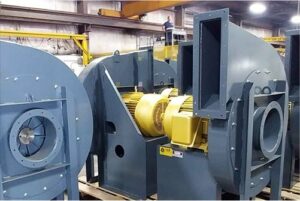Proper ventilation relies on a good industrial exhaust system. In industrial facilities, you may need both general and local exhaust systems to provide a complete ventilation solution. Blowers, also known as centrifugal fans, are an essential component of any exhaust system. In this article, we will discuss how a blower helps with exhaust in industrial ventilation systems and how to choose the right exhaust fan for your facility’s needs.
What Role do Blowers Play in an Industrial Exhaust System?
Blowers are a type of industrial fan that can move large amounts of air. This makes them perfect for an industrial exhaust system. These fans are durable and incredibly powerful. They can handle large volumes of air, both clean and contaminated. Industrial centrifugal fans can stand up to many harsh conditions, including moving heavily contaminated air with large amounts of particulates.

In a complete ventilation solution, blowers are best used for local exhaust systems such as dust and heat collection. For this function they are well suited to take in contaminated air and move it through the ducting until it reaches the exterior of the building. Blowers use centrifugal force to draw air into the center of the fan before directing the air outward at a 90° angle. This force can accelerate the air to high speeds and pressures to assist with exhausting contaminated air. Compared to axial fans, blowers provide stronger and more stable airflow, making them a better solution for local exhaust systems. Therefore, blowers can be one of the most essential components of an industrial exhaust system.
Selecting the Right Centrifugal Fans for Local Exhaust Systems
Of course, it’s critical to choose the right centrifugal fan for your local exhaust system. Choosing the incorrect blower can have many negative consequences for the complete ventilation solution. It can impact your facility’s safety, air quality, and comfort. Our ventilation specialists can help you identify solutions that work best for you.
One of the first considerations when choosing the right exhaust fan is how powerful it is. You need a fan with enough output to handle your local exhaust needs. Generally, this depends on the CFM (cubic feet per minute) rating for the fan. The higher the CFM, the more volume the fan can handle.
It’s also important to consider whether the fan can endure the exhausted material. In many facilities, the local exhaust simply handles hot, humid air with small amounts of dust and allergens. However, in many other industrial facilities, exhaust blowers will need to stand up to large amounts of contaminants. Therefore, your ventilation specialist will need to ensure that the fan is designed to handle your facility’s specific contaminant concerns.
Also, let’s not forget noise. Blowers are powerful, but they can also be noisy. Your ventilation specialist will look at sound ratings to help find the right fan for your exhaust needs. In some cases, the blowers create a lot of noise because you need high powered fans. In these cases, you may need ventilation system noise control solutions, such as through blower silencers. Your ventilation system experts can help you find the ideal solutions for your facility.
Eldridge Helps You Create Successful Environments Through Ventilation Solutions
Our team at Eldridge is dedicated to creating successful environments for people, products, and processes through superior ventilation systems and products. We offer over 75 years of experience in the industry. Our team provides ventilation and noise control solutions for facilities throughout the nation. You can trust us to find practical, durable, and high quality solutions for your facility’s ventilation needs. Contact us now to request a quote for system design, installation, or maintenance.

